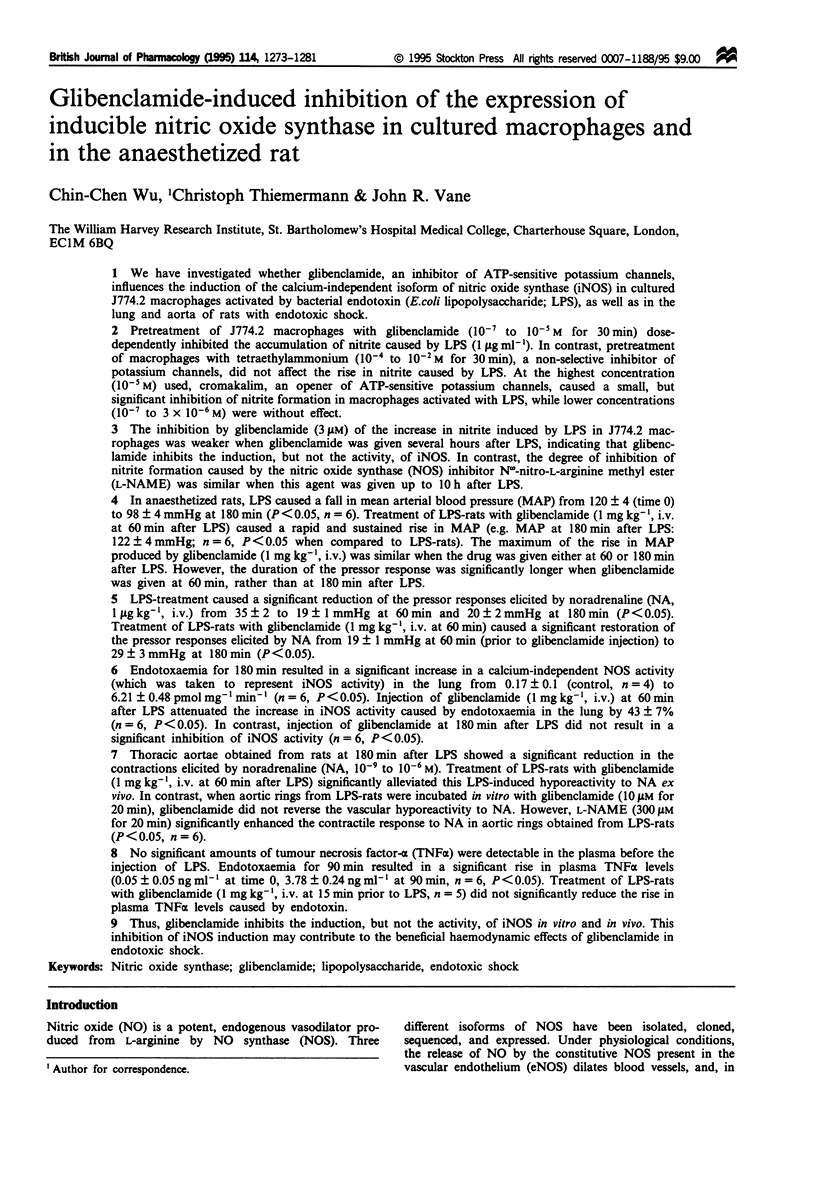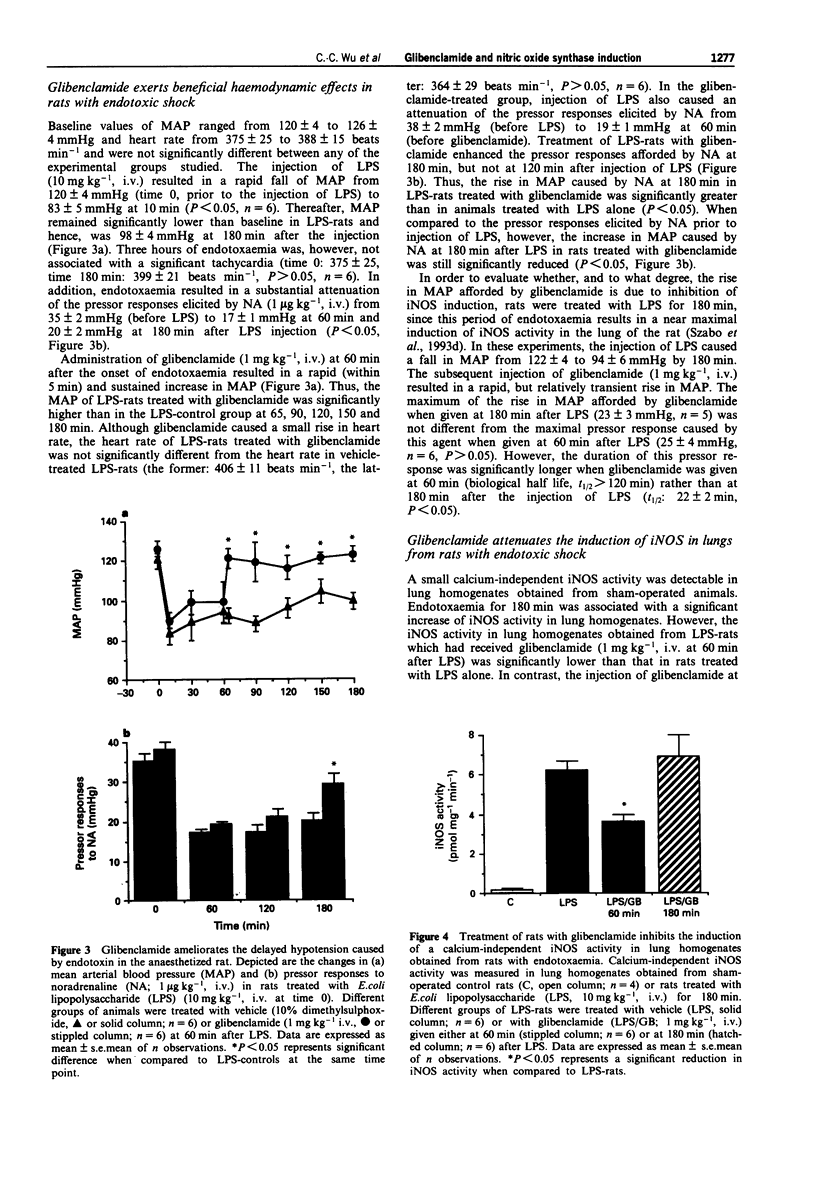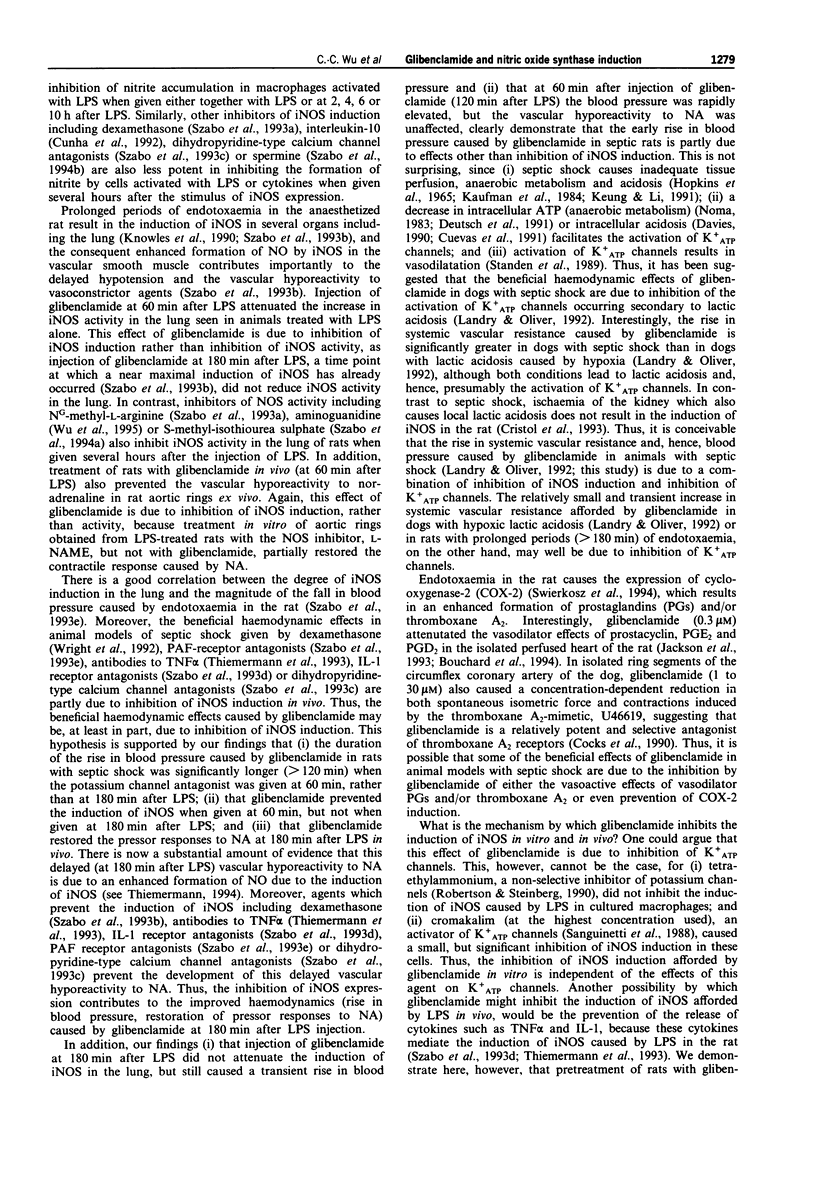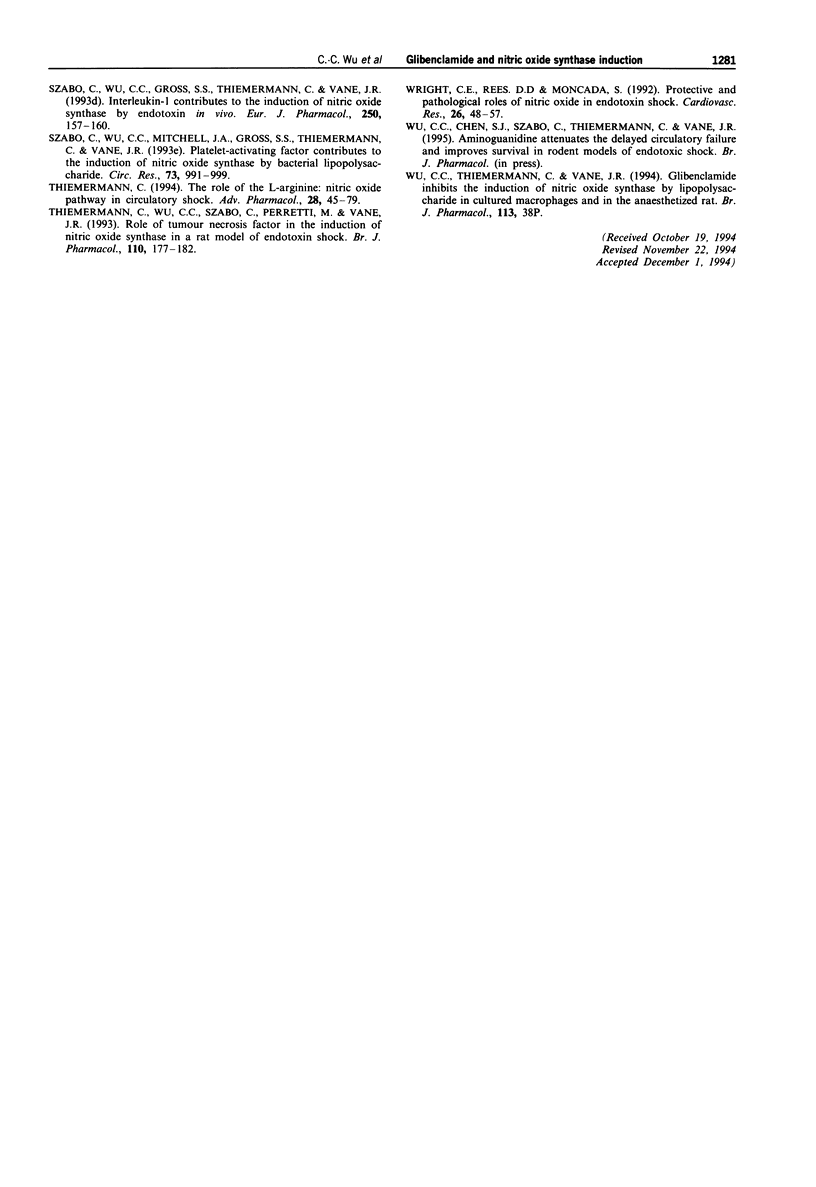Abstract
1. We have investigated whether glibenclamide, an inhibitor of ATP-sensitive potassium channels, influences the induction of the calcium-independent isoform of nitric oxide synthase (iNOS) in cultured J774.2 macrophages activated by bacterial endotoxin (E.coli lipopolysaccharide; LPS), as well as in the lung and aorta of rats with endotoxic shock. 2. Pretreatment of J774.2 macrophages with glibenclamide (10(-7) to 10(-5) M for 30 min) dose-dependently inhibited the accumulation of nitrite caused by LPS (1 microgram ml-1). In contrast, pretreatment of macrophages with tetraethylammonium (10(-4) to 10(-2) M for 30 min), a non-selective inhibitor of potassium channels, did not affect the rise in nitrite caused by LPS. At the highest concentration (10(-5) M) used, cromakalim, an opener of ATP-sensitive potassium channels, caused a small, but significant inhibition of nitrite formation in macrophages activated with LPS, while lower concentrations (10(-7) to 3 x 10(-6) M) were without effect. 3. The inhibition by glibenclamide (3 microM) of the increase in nitrite induced by LPS in J774.2 macrophages was weaker when glibenclamide was given several hours after LPS, indicating that glibenclamide inhibits the induction, but not the activity, of iNOS. In contrast, the degree of inhibition of nitrite formation caused by the nitric oxide synthase (NOS) inhibitor N omega-nitro-L-arginine methyl ester (L-NAME) was similar when this agent was given up to 10 h after LPS.(ABSTRACT TRUNCATED AT 250 WORDS)
Full text
PDF








Selected References
These references are in PubMed. This may not be the complete list of references from this article.
- Bouchard J. F., Dumont E., Lamontagne D. Evidence that prostaglandins I2, E2, and D2 may activate ATP sensitive potassium channels in the isolated rat heart. Cardiovasc Res. 1994 Jun;28(6):901–905. doi: 10.1093/cvr/28.6.901. [DOI] [PubMed] [Google Scholar]
- Bradford M. M. A rapid and sensitive method for the quantitation of microgram quantities of protein utilizing the principle of protein-dye binding. Anal Biochem. 1976 May 7;72:248–254. doi: 10.1006/abio.1976.9999. [DOI] [PubMed] [Google Scholar]
- Cocks T. M., King S. J., Angus J. A. Glibenclamide is a competitive antagonist of the thromboxane A2 receptor in dog coronary artery in vitro. Br J Pharmacol. 1990 Jun;100(2):375–378. doi: 10.1111/j.1476-5381.1990.tb15812.x. [DOI] [PMC free article] [PubMed] [Google Scholar]
- Cristol J. P., Thiemermann C., Mitchell J. A., Walder C., Vane J. R. Support of renal blood flow after ischaemic-reperfusion injury by endogenous formation of nitric oxide and of cyclo-oxygenase vasodilator metabolites. Br J Pharmacol. 1993 May;109(1):188–194. doi: 10.1111/j.1476-5381.1993.tb13552.x. [DOI] [PMC free article] [PubMed] [Google Scholar]
- Cuevas J., Bassett A. L., Cameron J. S., Furukawa T., Myerburg R. J., Kimura S. Effect of H+ on ATP-regulated K+ channels in feline ventricular myocytes. Am J Physiol. 1991 Sep;261(3 Pt 2):H755–H761. doi: 10.1152/ajpheart.1991.261.3.H755. [DOI] [PubMed] [Google Scholar]
- Cunha F. Q., Moncada S., Liew F. Y. Interleukin-10 (IL-10) inhibits the induction of nitric oxide synthase by interferon-gamma in murine macrophages. Biochem Biophys Res Commun. 1992 Feb 14;182(3):1155–1159. doi: 10.1016/0006-291x(92)91852-h. [DOI] [PubMed] [Google Scholar]
- Davies N. W. Modulation of ATP-sensitive K+ channels in skeletal muscle by intracellular protons. Nature. 1990 Jan 25;343(6256):375–377. doi: 10.1038/343375a0. [DOI] [PubMed] [Google Scholar]
- Deutsch N., Klitzner T. S., Lamp S. T., Weiss J. N. Activation of cardiac ATP-sensitive K+ current during hypoxia: correlation with tissue ATP levels. Am J Physiol. 1991 Sep;261(3 Pt 2):H671–H676. doi: 10.1152/ajpheart.1991.261.3.H671. [DOI] [PubMed] [Google Scholar]
- Gross S. S., Jaffe E. A., Levi R., Kilbourn R. G. Cytokine-activated endothelial cells express an isotype of nitric oxide synthase which is tetrahydrobiopterin-dependent, calmodulin-independent and inhibited by arginine analogs with a rank-order of potency characteristic of activated macrophages. Biochem Biophys Res Commun. 1991 Aug 15;178(3):823–829. doi: 10.1016/0006-291x(91)90965-a. [DOI] [PubMed] [Google Scholar]
- Gross S. S., Levi R. Tetrahydrobiopterin synthesis. An absolute requirement for cytokine-induced nitric oxide generation by vascular smooth muscle. J Biol Chem. 1992 Dec 25;267(36):25722–25729. [PubMed] [Google Scholar]
- HOPKINS R. W., SABGA G., PENN I., SIMEONE F. A. HEMODYNAMIC ASPECTS OF HEMORRHAGIC AND SEPTIC SHOCK. JAMA. 1965 Mar 1;191:731–735. doi: 10.1001/jama.1965.03080090045010. [DOI] [PubMed] [Google Scholar]
- Ikegami H., Shima K., Tanaka A., Tahara Y., Hirota M., Kumahara Y. Interindividual variation in the absorption of glibenclamide in man. Acta Endocrinol (Copenh) 1986 Apr;111(4):528–532. doi: 10.1530/acta.0.1110528. [DOI] [PubMed] [Google Scholar]
- Jackson W. F., König A., Dambacher T., Busse R. Prostacyclin-induced vasodilation in rabbit heart is mediated by ATP-sensitive potassium channels. Am J Physiol. 1993 Jan;264(1 Pt 2):H238–H243. doi: 10.1152/ajpheart.1993.264.1.H238. [DOI] [PubMed] [Google Scholar]
- Kaufman B. S., Rackow E. C., Falk J. L. The relationship between oxygen delivery and consumption during fluid resuscitation of hypovolemic and septic shock. Chest. 1984 Mar;85(3):336–340. doi: 10.1378/chest.85.3.336. [DOI] [PubMed] [Google Scholar]
- Keung E. C., Li Q. Lactate activates ATP-sensitive potassium channels in guinea pig ventricular myocytes. J Clin Invest. 1991 Nov;88(5):1772–1777. doi: 10.1172/JCI115497. [DOI] [PMC free article] [PubMed] [Google Scholar]
- Landry D. W., Oliver J. A. The ATP-sensitive K+ channel mediates hypotension in endotoxemia and hypoxic lactic acidosis in dog. J Clin Invest. 1992 Jun;89(6):2071–2074. doi: 10.1172/JCI115820. [DOI] [PMC free article] [PubMed] [Google Scholar]
- Lechner A. J., Rouben L. R., Potthoff L. H., Tredway T. L., Matuschak G. M. Effects of pentoxifylline on tumor necrosis factor production and survival during lethal E. coli sepsis vs. disseminated candidiasis with fungal septic shock. Circ Shock. 1993 Apr;39(4):306–315. [PubMed] [Google Scholar]
- Lechner A. J., Tredway T. L., Brink D. S., Klein C. A., Matuschak G. M. Differential systemic and intrapulmonary TNF-alpha production in Candida sepsis during immunosuppression. Am J Physiol. 1992 Nov;263(5 Pt 1):L526–L535. doi: 10.1152/ajplung.1992.263.5.L526. [DOI] [PubMed] [Google Scholar]
- Moncada S., Higgs A. The L-arginine-nitric oxide pathway. N Engl J Med. 1993 Dec 30;329(27):2002–2012. doi: 10.1056/NEJM199312303292706. [DOI] [PubMed] [Google Scholar]
- Moore P. K., al-Swayeh O. A., Chong N. W., Evans R. A., Gibson A. L-NG-nitro arginine (L-NOARG), a novel, L-arginine-reversible inhibitor of endothelium-dependent vasodilatation in vitro. Br J Pharmacol. 1990 Feb;99(2):408–412. doi: 10.1111/j.1476-5381.1990.tb14717.x. [DOI] [PMC free article] [PubMed] [Google Scholar]
- Noma A. ATP-regulated K+ channels in cardiac muscle. Nature. 1983 Sep 8;305(5930):147–148. doi: 10.1038/305147a0. [DOI] [PubMed] [Google Scholar]
- Pittner R. A., Spitzer J. A. Endotoxin and TNF alpha directly stimulate nitric oxide formation in cultured rat hepatocytes from chronically endotoxemic rats. Biochem Biophys Res Commun. 1992 May 29;185(1):430–435. doi: 10.1016/s0006-291x(05)81003-4. [DOI] [PubMed] [Google Scholar]
- Robertson D. W., Steinberg M. I. Potassium channel modulators: scientific applications and therapeutic promise. J Med Chem. 1990 Jun;33(6):1529–1541. doi: 10.1021/jm00168a001. [DOI] [PubMed] [Google Scholar]
- Sanguinetti M. C., Scott A. L., Zingaro G. J., Siegl P. K. BRL 34915 (cromakalim) activates ATP-sensitive K+ current in cardiac muscle. Proc Natl Acad Sci U S A. 1988 Nov;85(21):8360–8364. doi: 10.1073/pnas.85.21.8360. [DOI] [PMC free article] [PubMed] [Google Scholar]
- Standen N. B., Quayle J. M., Davies N. W., Brayden J. E., Huang Y., Nelson M. T. Hyperpolarizing vasodilators activate ATP-sensitive K+ channels in arterial smooth muscle. Science. 1989 Jul 14;245(4914):177–180. doi: 10.1126/science.2501869. [DOI] [PubMed] [Google Scholar]
- Szabó C., Mitchell J. A., Gross S. S., Thiemermann C., Vane J. R. Nifedipine inhibits the induction of nitric oxide synthase by bacterial lipopolysaccharide. J Pharmacol Exp Ther. 1993 May;265(2):674–680. [PubMed] [Google Scholar]
- Szabó C., Mitchell J. A., Thiemermann C., Vane J. R. Nitric oxide-mediated hyporeactivity to noradrenaline precedes the induction of nitric oxide synthase in endotoxin shock. Br J Pharmacol. 1993 Mar;108(3):786–792. doi: 10.1111/j.1476-5381.1993.tb12879.x. [DOI] [PMC free article] [PubMed] [Google Scholar]
- Szabó C., Southan G. J., Wood E., Thiemermann C., Vane J. R. Inhibition by spermine of the induction of nitric oxide synthase in J774.2 macrophages: requirement of a serum factor. Br J Pharmacol. 1994 Jun;112(2):355–356. doi: 10.1111/j.1476-5381.1994.tb13078.x. [DOI] [PMC free article] [PubMed] [Google Scholar]
- Szabó C., Thiemermann C., Vane J. R. Dihydropyridine antagonists and agonists of calcium channels inhibit the induction of nitric oxide synthase by endotoxin in cultured macrophages. Biochem Biophys Res Commun. 1993 Oct 29;196(2):825–830. doi: 10.1006/bbrc.1993.2323. [DOI] [PubMed] [Google Scholar]
- Thiemermann C. The role of the L-arginine: nitric oxide pathway in circulatory shock. Adv Pharmacol. 1994;28:45–79. doi: 10.1016/s1054-3589(08)60493-7. [DOI] [PubMed] [Google Scholar]
- Thiemermann C., Wu C. C., Szabó C., Perretti M., Vane J. R. Role of tumour necrosis factor in the induction of nitric oxide synthase in a rat model of endotoxin shock. Br J Pharmacol. 1993 Sep;110(1):177–182. doi: 10.1111/j.1476-5381.1993.tb13789.x. [DOI] [PMC free article] [PubMed] [Google Scholar]
- Wright C. E., Rees D. D., Moncada S. Protective and pathological roles of nitric oxide in endotoxin shock. Cardiovasc Res. 1992 Jan;26(1):48–57. doi: 10.1093/cvr/26.1.48. [DOI] [PubMed] [Google Scholar]


